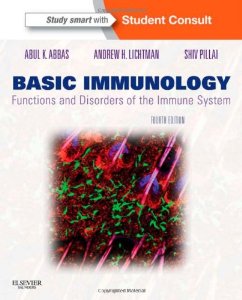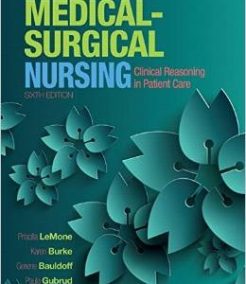Description
Basic Immunology: Functions and Disorders of the Immune System
Basic Immunology: Functions and Disorders of the Immune System Abul K Abbas
Basic Immunology: Functions and Disorders of the Immune System Abul K Abbas 4th
Basic Immunology: Functions and Disorders of the Immune System Abul K Abbas 4th Test Bank
Test Bank for Basic Immunology Functions and Disorders of the Immune System 4th Edition Abul K Abbas Download
***THIS IS NOT THE ACTUAL BOOK. YOU ARE BUYING the Test Bank in e-version of the following book***
Name: Basic Immunology: Functions and Disorders of the Immune System
Author: Abul K Abbas
Edition: 4th
ISBN-10: 1455707074
ISBN-13: 978-1455707072
Type: Test Bank
– The test bank is what most professors use an a reference when making exams for their students, which means there’s a very high chance that you will see a very similar, if not exact the exact, question in the test!
– The file is either in pdf, doc, rtf or zipped in the package and can easily be read on PCs and Macs.
– Delivery is INSTANT. You can download the files IMMEDIATELY once payment is done.
If you have any questions, please feel free to contact us. Our response is the fastest. All questions will always be answered in 6 hours., most of the time within 30mins
We also faced similar difficulities when we were students, and we understand how you feel.
But now, with the Basic Immunology: Functions and Disorders of the Immune System 4th Test Bank, you will be able to
* Anticipate the type of the questions that will appear in your exam.
* Reduces the hassle and stress of your student life.
* Improve your studying and also get a better grade!
* Get prepared for examination questions.
* Can save you time and help you understand the material.
This is the quality of service we are providing and we hope to be your helper.
Delivery is in the next moment. Test Bank is accurate.
Prepare to receive your Basic Immunology: Functions and Disorders of the Immune System 4th Test Bank in the next moment.
ISBN-10: 1455707074
ISBN-13: 978-1455707072
If you have any questions, or would like a receive a sample chapter before your purchase, please contact us at inquiry@testbankcorp.com
Basic Immunology: Functions and Disorders of the Immune System
Basic Immunology: Functions and Disorders of the Immune System Abul K Abbas
Basic Immunology: Functions and Disorders of the Immune System Abul K Abbas 4th
Basic Immunology: Functions and Disorders of the Immune System Abul K Abbas 4th Test Bank
Test Bank for Basic Immunology Functions and Disorders of the Immune System 4th Edition Abul K Abbas Download
Abbas: Basic Immunology, 4th Edition
Chapter 01: Introduction to the Immune System
Test Bank
MULTIPLE CHOICE
1. The principal function of the immune system is:
A. Defense against cancer
B. Repair of injured tissues
C. Defense against microbial infections
D. Prevention of inflammatory diseases
E. Protection against environmental toxins
ANS: C
The immune system has evolved in the setting of selective pressures imposed by microbial infections. Although immune responses to cancer may occur, the concept that “immunosurveillance” against cancer is a principal function of the immune system is controversial. Repair of injured tissues may be a secondary consequence of the immune responses and inflammation. Although the immune system has regulatory features that are needed to prevent excessive inflammation, prevention of inflammatory diseases is not a primary function. The immune system can protect against microbial toxins, but it generally does not offer protection against toxins of nonbiologic origin.
2. Which of the following infectious diseases was prevented by the first successful vaccination?
A. Polio
B. Tuberculosis
C. Smallpox
D. Tetanus
E. Rubella
ANS: C
In 1798, Edward Jenner reported the first intentional successful vaccination, which was against smallpox in a boy, using material from the cowpox pustules of a milkmaid. In 1980, smallpox was reported to be eradicated worldwide by a vaccination program. Effective vaccines against tetanus toxin, rubella virus, and poliovirus were developed in the 20th century and are widely used. There is no effective vaccine against Mycobacterium tuberculosis.
3. A previously healthy 8-year-old boy is infected with an upper respiratory tract virus for the first time. During the first few hours of infection, which one of the following events occurs?
A. The adaptive immune system responds rapidly to the virus and keeps the viral infection under control.
B. The innate immune system responds rapidly to the viral infection and keeps the viral infection under control.
C. Passive immunity mediated by maternal antibodies limits the spread of infection.
D. B and T lymphocytes recognize the virus and stimulate the innate immune response.
E. The virus causes malignant transformation of respiratory mucosal epithelial cells, and the malignant cells are recognized by the adaptive immune system.
ANS: B
The innate immune response to microbes develops within hours of infection, well before the adaptive immune response. B and T lymphocytes are components of the adaptive immune response, and they would not be able to respond to a newly encountered virus before the innate immune response. An 8-year-old boy would no longer have maternal antibodies from transplacental passive transfer and is unlikely to be breast-feeding, which is another potential source of maternal antibodies. Malignant transformation takes months or years to develop.
4. Which of the following is a unique property of the adaptive immune system?
A. Highly diverse repertoire of specificities for antigens
B. Self-nonself discrimination
C. Recognition of microbial structures by both cell-associated and soluble receptors
D. Protection against viral infections
E. Responses that have the same kinetics and magnitude on repeated exposure to the same microbe
ANS: A
Highly diverse repertoires of specificities for antigens are found only in T and B lymphocytes, which are the central cellular components of the adaptive immune system. Both the innate and the adaptive immune systems use cell-associated and soluble receptors to recognize microbes, display some degree of self-nonself discrimination, and protect against viruses. On repeated exposure to the same microbe, the adaptive immune response becomes more rapid and of greater magnitude; this is the manifestation of memory.
5. Antibodies and T lymphocytes are the respective mediators of which two types of immunity?
A. Innate and adaptive
B. Passive and active
C. Specific and nonspecific
D. Humoral and cell-mediated
E. Adult and neonatal
ANS: D
Both B and T lymphocytes are principal components of adaptive immunity. B lymphocytes produce antibodies, which are the recognition and effector molecules of humoral immune responses to extracellular pathogens. T cells recognize and promote eradication of intracellular pathogens in cell-mediated immunity. Passive and active immunity both can be mediated by either B or T lymphocytes. Specific immunity is another term for adaptive immunity. Both B and T lymphocytes participate in adult adaptive immunity but are still developing in the neonatal period.
6. A standard treatment of animal bite victims, when there is a possibility that the animal was infected with the rabies virus, is administration of human immunoglobulin preparations containing anti–rabies virus antibodies. Which type of immunity would be established by this treatment?
A. Active humoral immunity
B. Passive humoral immunity
C. Active cell-mediated immunity
D. Passive cell-mediated immunity
E. Innate immunity
ANS: B
Humoral immunity is mediated by antibodies. The transfer of protective antibodies made by one or more individuals into another individual is a form of passive humoral immunity. Active immunity to an infection develops when an individual’s own immune system responds to the microbe. Cell-mediated immunity is mediated by T lymphocytes, not antibodies, and innate immunity is not mediated by either antibodies or T lymphocytes.
7. At 15 months of age, a child received a measles-mumps-rubella vaccine (MMR). At age 22, she is living with a family in Mexico that has not been vaccinated and she is exposed to measles. Despite the exposure, she does not become infected. Which of the following properties of the adaptive immune system is best illustrated by this scenario?
A. Specificity
B. Diversity
C. Specialization
D. Memory
E. Nonreactivity to self
ANS: D
Protection against infections after vaccination is due to immunologic memory of the adaptive immune system. Memory is manifested as a more rapidly developing and vigorous response on repeat exposure to an antigen compared with the first exposure. Specificity and diversity are properties related to the range of antigenic structures recognized by the immune system, and specialization is the ability of the adaptive immune system to use distinct effector mechanisms for distinct infections.
8. A vaccine administered in the autumn of one year may protect against the prevalent strain of influenza virus that originated in Hong Kong that same year, but it will not protect against another strain of influenza virus that originated in Russia. This phenomenon illustrates which property of the adaptive immune system?
A. Specificity
B. Amnesia
C. Specialization
D. Cultural diversity
E. Self-tolerance
ANS: A
Adaptive immune responses are highly specific for distinct molecular structures, which may be present in a vaccine and be produced by one strain of virus but not by a closely related strain. Amnesia, although generally not used in immunology, implies lack of memory, but the efficacy of the vaccine against the Hong Kong strain implies it has induced memory. The same effector mechanisms would be required to combat different strains of influenza, and therefore failure of a vaccine to protect against two different strains of virus is not related to specialization of effector functions.
9. The two major functional classes of effector T lymphocytes are:
A. Helper T lymphocytes and cytotoxic T lymphocytes
B. Natural killer cells and cytotoxic T lymphocytes
C. Memory T cells and effector T cells
D. Helper cells and antigen-presenting cells
E. Cytotoxic T lymphocytes and target cells
ANS: A
T cells can be classified into effector subsets that perform different effector functions. Most effector T cells are either helper T lymphocytes, which promote macrophage and B cell responses to infections, or cytotoxic T lymphocytes, which directly kill infected cells. Natural killer cells are not T lymphocytes. Antigen-presenting cells usually are not T cells. Memory T cells are not effector T cells.
10. Which of the following cell types is required for all humoral immune responses?
A. Natural killer cells
B. Dendritic cells
C. Cytolytic T lymphocytes
D. B lymphocytes
E. Helper T lymphocytes
ANS: D
Humoral immune responses are antibody-mediated immune responses, and all antibodies are made by B lymphocytes and by no other cell type.
11. During a humoral immune response to a newly encountered bacterial infection, B cells are first stimulated to proliferate and then secrete antibodies specific for the bacterium. The antibodies may then bind to the bacteria and facilitate ingestion of the microbes by phagocytic cells. In what phase of the humoral immune response does the binding of secreted antibodies to bacteria occur?
A. Recognition phase
B. Activation phase
C. Effector phase
D. Homeostatic phase
E. Memory phase
ANS: C
The effector phase of an immune response occurs when cells or molecules eliminate the microbe or microbial toxin. In a humoral immune response, the effector phase includes secretion of antibody, binding of the antibody to the microbe or toxin, and subsequent antibody-dependent elimination of the microbe or toxin. The recognition phase is the initial binding of the antigen by the naive lymphocyte. The activation phase includes proliferation and differentiation of lymphocytes in response to antigen recognition. The homeostatic phase follows the effector phase, during which the response wanes. In the memory phase, memory B cells and antibodies secreted by long-lived antibody-secreting cells are “waiting” for a repeat exposure to the microbe.
12. Which of the following statements is consistent with the process of clonal selection?
A. The specificity of a lymphocyte antigen receptor changes to accommodate the structure of an antigen that binds to it.
B. Many different antigen receptors with different specificities are expressed on each lymphocyte.
C. Lymphocytes do not express antigen receptors on their cell surfaces until after exposure to antigen.
D. The diversity of the lymphocyte repertoire for antigens is very small before exposure to antigen but increases significantly after antigen exposure.
E. The diversity of the lymphocyte repertoire for antigens is very large before exposure to antigen, with millions of different clones of lymphocytes, each having a different specificity.
ANS: E
The clonal selection hypothesis accurately predicted that individuals possess large numbers of different clones of lymphocytes before antigen exposure, with cells in each clone expressing antigen receptors with a single identical specificity, but with different specificities from other clones. Thus, the diversity of the lymphocyte repertoire is very large even before antigen exposure. These receptors are expressed before antigen exposure, and their specificities generally do not change in response to antigen.
13. Which of the following best describes clonal expansion in adaptive immune responses?
A. Increased number of different lymphocyte clones, each clone specific for a different antigen during the course of an infection
B. Increased number of different lymphocyte clones, each clone specific for a different antigen during development of the immune system, before exposure to antigen
C. Increased number of lymphocytes with identical specificities, all derived from a single lymphocyte due to nonspecific stimuli from the innate immune system
D. Increased number of lymphocytes with identical specificities, all derived from a single lymphocyte stimulated by a single antigen
E. Increased size of the lymphocytes of a single clone due to antigen-induced activation of the cells
ANS: D
Clonal expansion occurs during the activation phase of an adaptive immune response. A single lymphocyte is stimulated to divide by antigen, and the progeny go through several rounds of division until there are many lymphocytes, all with identical specificities, all derived from one cell. The number of different clones is not influenced by antigen exposure. Expansion does not refer to the size of the cells, although activated lymphocytes are larger than their naive precursors.
14. The estimated number of distinct structures that can be recognized by the mammalian adaptive immune system is
A. 1-10
B. 102-103
C. 103-105
D. 107-109
E. ?
ANS: D
Although the theoretical number of antigen specificities of the adaptive immune system is higher, estimates of the actual number of different antibody and T cell antigen receptor specificities are in the range of 107-109. This number is large enough to accommodate most of the diversity in molecular structures that the microbial world is capable of producing.
15. Which of the following statements best describes the “two-signal requirement” for naive lymphocyte activation?
A. Lymphocytes must recognize two different antigens to become activated.
B. Lymphocytes must recognize the same antigen at two sequential times to become activated.
C. Lymphocytes must recognize antigen and respond to another signal generated by microbial infection to become activated.
D. Both naive B and naive T lymphocytes must simultaneously recognize antigen for either to be activated.
E. When lymphocytes recognize antigen, the antigen receptors must activate two-signal transduction pathways to become activated.
ANS: C
Naive lymphocytes will not become activated by antigen alone (signal 1). In addition, they require “costimulatory” signals (signal 2), which are either microbial products or molecules on host cells induced by microbial infection. The molecules that provide signal 2 bind to receptors on the lymphocytes that are distinct from the clonally distributed antigen receptors. Each lymphocyte cannot generally recognize more than one antigen. Although lymphocyte activation may require recognition of antigen molecules by more than one antigen receptor, the two-signal requirement does not refer to this. There is no general requirement for both T and B cells to recognize the same antigen for activation of either to occur. The two-signal requirement does not refer to antigen receptor–associated signal transduction pathways.
16. In addition to T cells, which cell type is required for initiation of all T cell–mediated immune responses?
A. Effector cells
B. Memory cells
C. Natural killer cells
D. Antigen-presenting cells
E. B lymphocytes
ANS: D
T cell–mediated immune responses are initiated when naive T cells are activated. Antigen-presenting cells, such as dendritic cells, are required to display antigens (peptide-MHC molecule complexes) for naive T cell recognition and to express costimulatory molecules also needed for T cell activation. Memory cells, cytotoxic T cells, and B lymphocytes are not involved in the initial activation of naive T lymphocytes.







Reviews
There are no reviews yet.